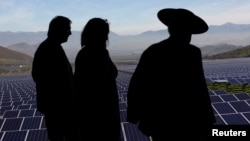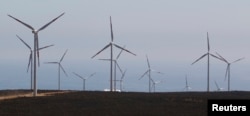The South American country of Chile likes to present itself as a worldwide leader on climate change.
Nearly 22 percent of Chile’s electricity comes from solar and wind energy production centers. That is a higher percentage than the United States with 13 percent. The world average is 10 percent. In 2008, Chile was also one of the first countries to declare a target for renewable energy.
However, imported natural gas, a fossil fuel like coal and oil, has continued because of a favorable supply deal won from the government.
Marcelo Mena is a former environment minister for Chile. He leads Global Methane Hub. The nonprofit group aims to reduce methane emissions around the world.
Mena said natural gas is basically methane. ”They’re actually hindering the power that we can deliver from renewable energy,” Mena told the Associated Press. “It’s been more of an opposition towards 100 percent renewable target.”
Mena said renewable energy is being pushed out by fossil fuels in northern Chile. “At the same time, in the south of Chile, there is a big lack of natural gas for heating and people are heating themselves with wood and choking on it,” said Mena.
Transition to renewable energy
The shock that led to the development of renewable energy in Chile came in the mid-2000s. At that time, Argentina greatly reduced gas exports to Chile to serve its own market. Chileans had limited electricity and power outages happened a lot.
Chile receives some of them most consistent sunshine in the world, especially in the northern Atacama Desert. So, the country sought investment in solar and wind projects. Chile requires electricity companies to offer a minimum amount of renewable energy.
Developers built hundreds of solar and wind plants. They also built systems that get energy from the Earth’s heat, called geothermal plants. These energy centers were placed throughout the country, which stretches 4,300 kilometers from north to south.
The government also invested in fossil fuel plants. Natural gas importers and owners of gas plants successfully argued that the power grid must take their electricity.
The importers must pay for gas under international contracts whether they need it or not. Under government regulations, they can declare electricity from gas imports “forced gas.” That means electricity produced from gas is favored in the power market which also supports renewables.
Ana Lía Rojas leads the Chilean Association of Renewable Energies and Storage. She said the rule “is a loss for the environment and for the energy transition.”
Another result of forcing electricity produced from gas into the market is that it lowers electricity prices for all providers.
Alfredo Solar is a solar plant supervisor. He said, “I have worked in solar plants that, for example, were in default because the market price was much lower than what was projected.” The term default means that they could not pay their debts. Solar providers, he said, operate without contracts and depend on market prices.
Last year, the Chilean government changed the rules for natural gas providers. Their electricity still enters the power grid at a reduced price. But it is not supposed to displace renewable energy. Supporters of renewables in Chile say the changes are not enough.
Large electricity storage systems are too costly to be widely used in Chile, said Daniel Salazar. He is a former executive director of Chile’s northern power grid who is now with the business advice firm EnergiE. He said gas remains a low-cost way to deal with the nation’s energy problems.
By 2030, solar producers could provide 30 percent of all electricity in Chile. The Association of Power Generators says that will make it the nation’s largest source of power.
I’m Mario Ritter Jr.
Diane Jeantet reported this story for the Associated Press. Hai Do adapted it for VOA Learning English.
_____________________________________________________________________
Words in This Story
hinder –v. to make an action slow or difficult
deliver –v. to provide
choke –v. to be unable to breathe
consistent –adj. to continue to happen or develop in the same way
minimum –adj. to least or lowest amount possible
power grid –n. a network of lines, structures and equipment that carry electricity from where it is produced to the places that use it
transition –n. a change from one condition to another
We want to hear from you. Write to us in the Comments section, and visit our Facebook page.












